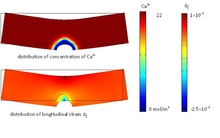Modeling of Chemo-Mechanical Coupled Behavior of Cement Based Material
A lixiviation-mechanical coupled model is developed for fiber reinforced concrete within this framework; both the influence of chemical degradation on short and long term mechanical behavior and the influence of mechanical loading on the diffusion coefficient can be considered.
The elastic mechanical properties are written as function of chemical damage. A Drucker–Prager typed criterion with associated flow rule is used with taking into account of mechanical damage and chemical damage. The diffusion coefficient is defined as a positive function of mechanical damage. The proposed model is implemented into COMSOL and validated from decoupled tests to fully coupled tests in order to progressively determine the model parameters. The proposed model can well describe the chemo-mechanical coupled behavior of cement based material.

Herunterladen
- hu_presentation.pdf - 0.91MB
- hu_paper.pdf - 0.19MB
